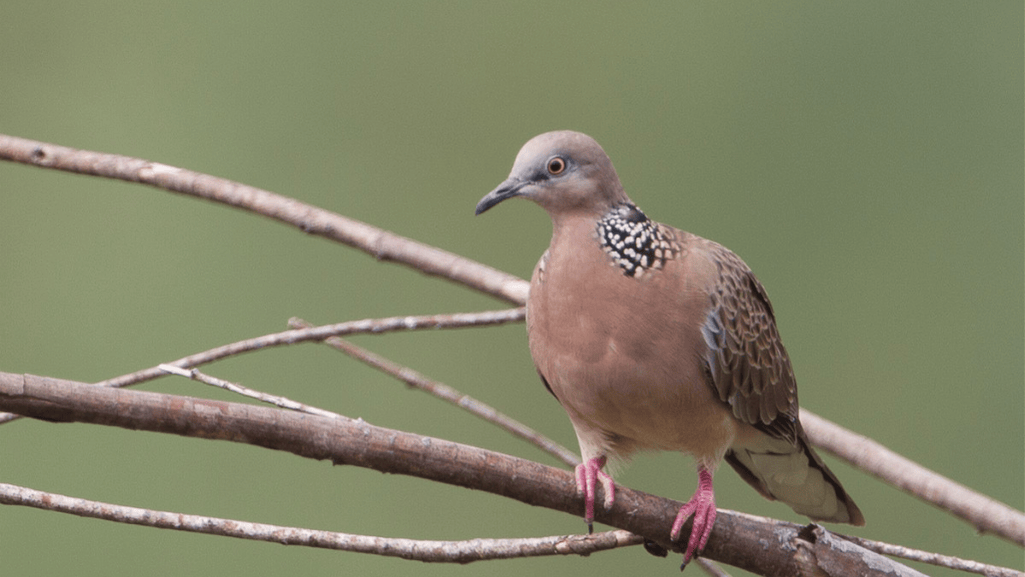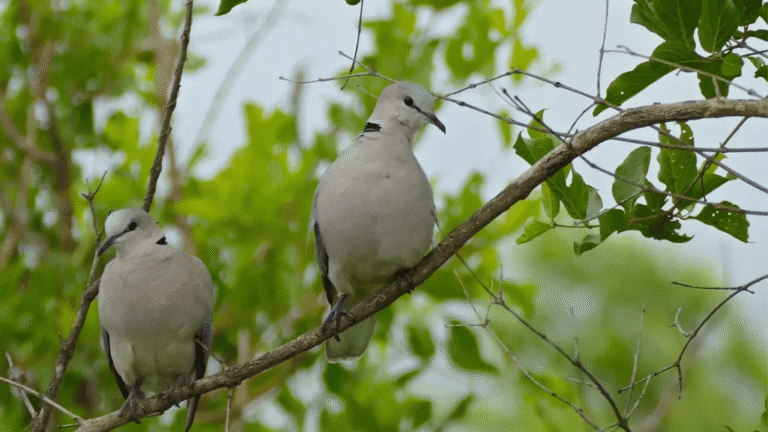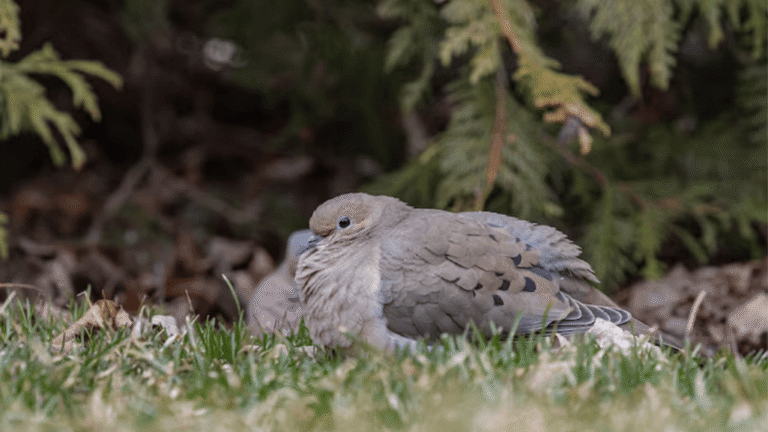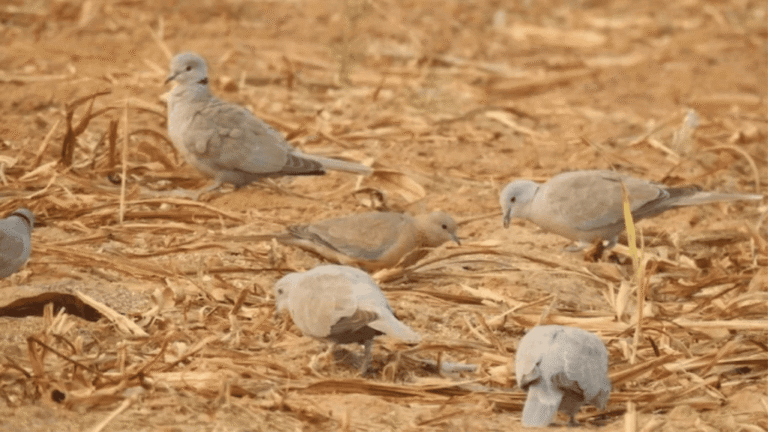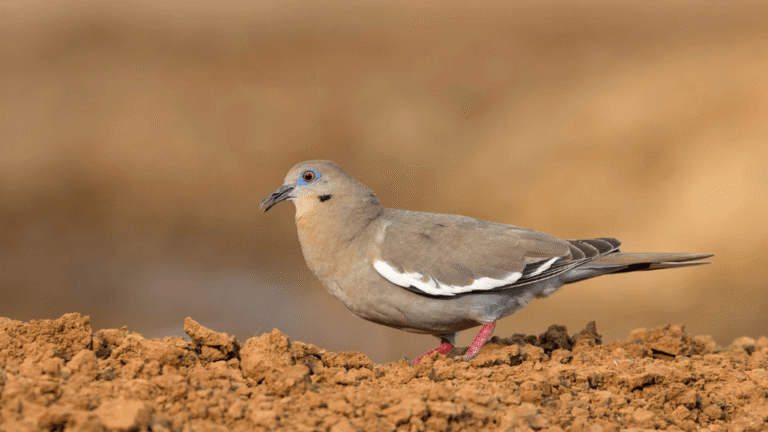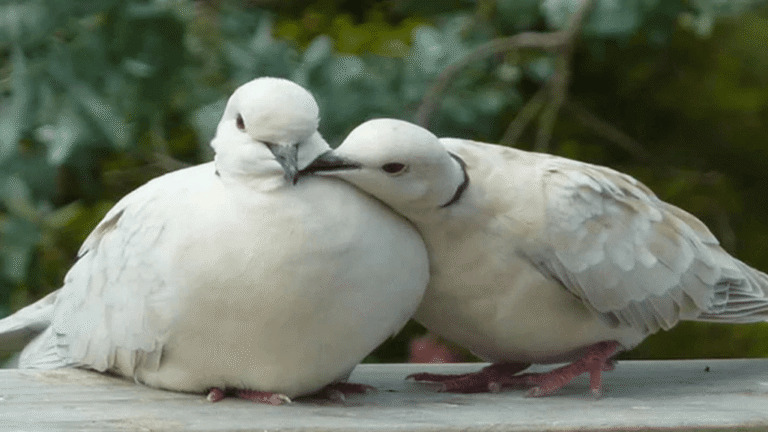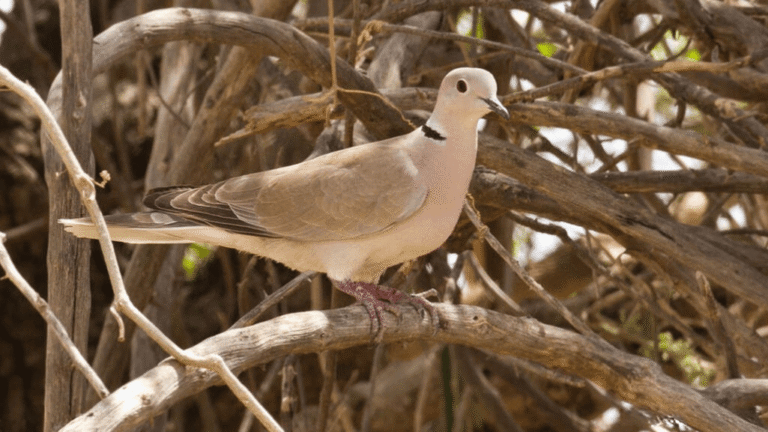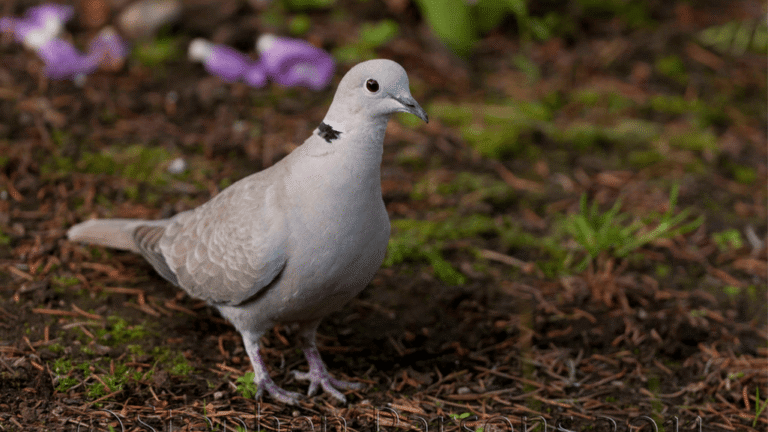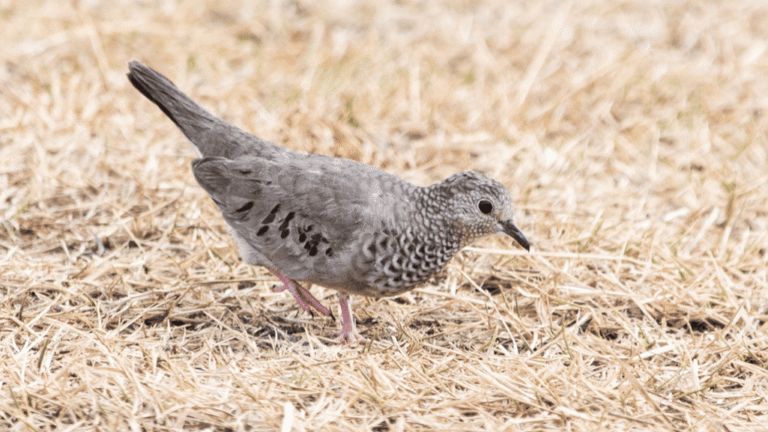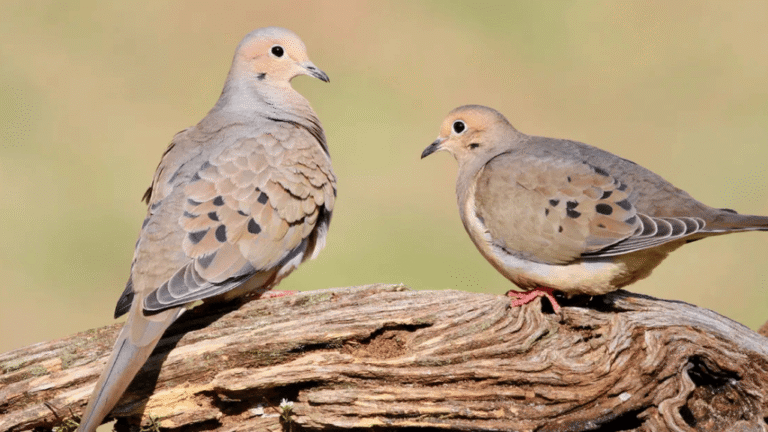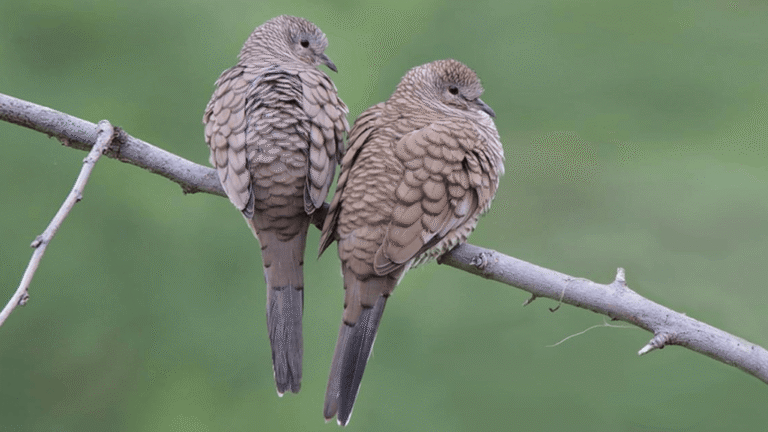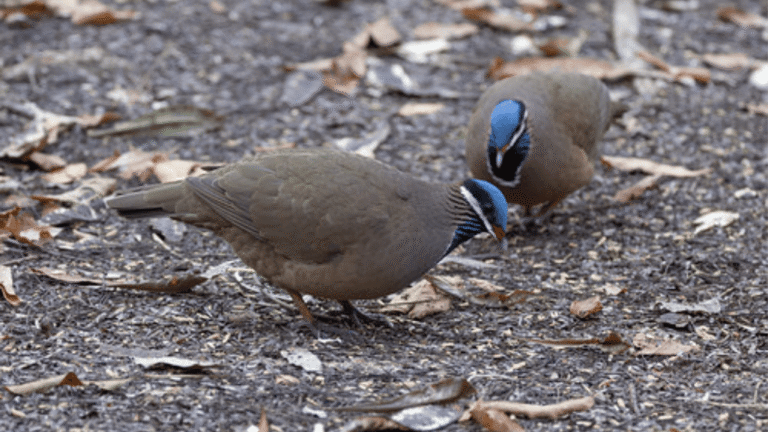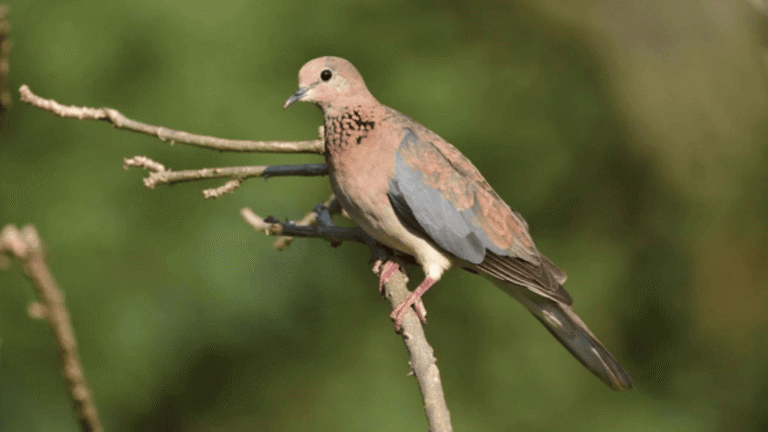The Spotted Dove (Spilopelia chinensis) is a graceful bird often associated with peace and purity. With soft, repeated coos and the distinctive spotted collar that gives it its common name, the spotted dove is easy to notice in both rural and urban settings. This article explores the Spotted Dove’s behavior, habitat preferences, and notable natural-history facts, with examples from Rajaji National Park in Uttarakhand, India.
Rajaji National Park hosts a diverse assemblage of birds, and records (see park checklists and eBird observations) confirm regular sightings of the spotted dove there. This adaptable dove thrives in open woodlands, farmlands, and gardens, demonstrating how a wild species can persist alongside people and in many parts of the world.
Key Takeaways
Spotted Dove (Spilopelia chinensis) — a familiar bird across many landscapes — is easy to spot in Rajaji National Park and other open woodlands.
Breeding: Spotted doves breed mainly from February to September in much of their range, although timing can vary regionally.
Diet: Their food primarily consists of seeds and grains, supplemented seasonally by fruits and small insects, especially during breeding.
Conservation: The species is currently listed as Least Concern by IUCN, but habitat loss, competition, and local pressures warrant monitoring.
Cultural role: The dove’s gentle cooing and spotted neck collar have long made it a symbol of peace and purity.
Ecotourism: Responsible birdwatching and local conservation programs (e.g., park guides, community initiatives) help protect the Spotted Dove and other birds while supporting local livelihoods.
How you can help: Record sightings on platforms such as eBird, avoid releasing non-native birds, and support habitat-friendly practices in gardens and farmland to benefit doves and broader biodiversity.
An Overview of the Spotted Dove Species
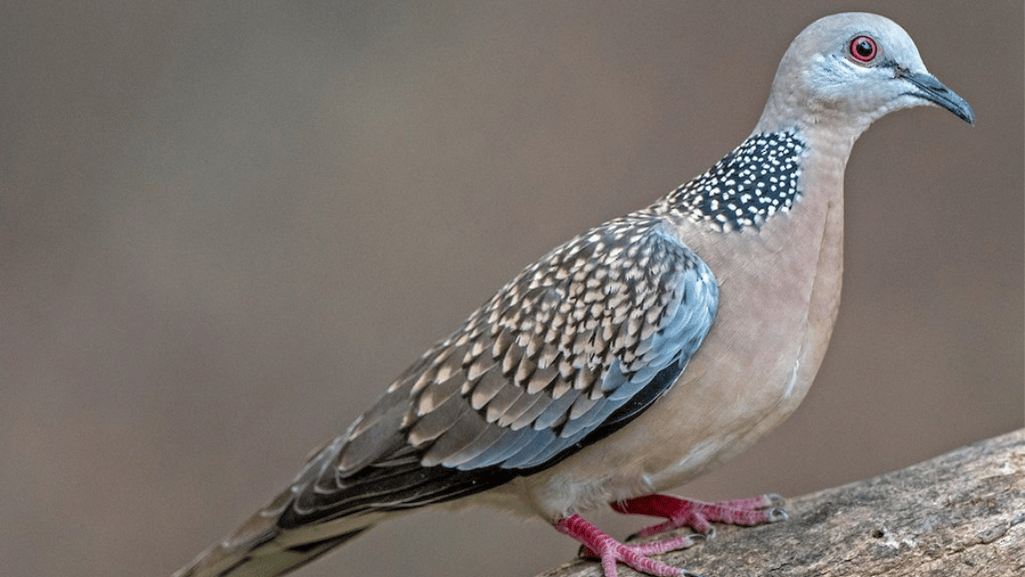 The Spotted Dove (Spilopelia chinensis) is a medium-sized dove recognizable by its spotted black-and-white neck collar and soft, repeated coos. Widespread across the Indian subcontinent and much of southern Asia, this adaptable species occupies open woodlands, agricultural areas, and urban gardens, illustrating how a wild bird can thrive in many parts of the world.
The Spotted Dove (Spilopelia chinensis) is a medium-sized dove recognizable by its spotted black-and-white neck collar and soft, repeated coos. Widespread across the Indian subcontinent and much of southern Asia, this adaptable species occupies open woodlands, agricultural areas, and urban gardens, illustrating how a wild bird can thrive in many parts of the world.
The Taxonomy and Name Origins of Spotted Dove
Described originally by Scopoli in 1786, the species is currently placed in the genus Spilopelia (formerly treated in Streptopelia). Modern checklists such as the IOC World Bird List reflect this split; consult the latest edition of regional handbooks or the IOC world bird list for up-to-date nomenclature and subspecies treatments.
Common English names include Chinese Dove, Pearl-necked Dove, and Lace-necked Dove, all referring to the diagnostic white spots on the dark nape and collar that are a key field mark for identification.
Physical Characteristics and Identification
The Spotted Dove typically measures about 27.5–30 cm in length (some sources and regional populations report up to ~33 cm) and usually weighs roughly 120–160 g depending on locality and subspecies. It has a buff-brown back and wings, a long tail, and a distinctive black collar with conspicuous white spots. Vocalizations are a soft, rhythmic series of cooing notes that help locate the bird in cover.
Field-note ID tips: look for the lace-like white spots on the black nape patch, the warm buff upperparts, and the long, graduated tail—together these distinguish Spilopelia chinensis from similar Streptopelia pigeons in many parts of its range.
Characteristic Description
Scientific Name Spilopelia chinensis
Common Names Chinese Dove, Pearl-necked Dove, Lace-necked Dove
Size 27.5–30 cm (regional reports up to ~33 cm)
Weight ~120–160 g (varies by population)
Vocalization Soft, repeated sequence of coos
Habitat Open woodlands, farmlands, urban areas, gardens
Diet Seeds, grains, small fruit, seasonal insects
This species contains several recognized subspecies with subtle regional plumage differences—consult the relevant handbook or the IOC world bird checklist (latest edition) for the current subspecific breakdown and distribution. For quick field use, emphasize the spotted collar, size, and soft cooing as the primary identification cues.
Diving into the Habitats of the Spotted Dove
The Spotted Dove (Spilopelia chinensis) is a flexible, largely non-migratory species whose presence across a wide range of habitats helps explain its success in many parts of the world. Knowing the Spotted Dove’s preferred environments and where it has become established is useful for birdwatchers, conservationists, and anyone interested in native range dynamics.
The Spotted Dove’s Preferred Environments
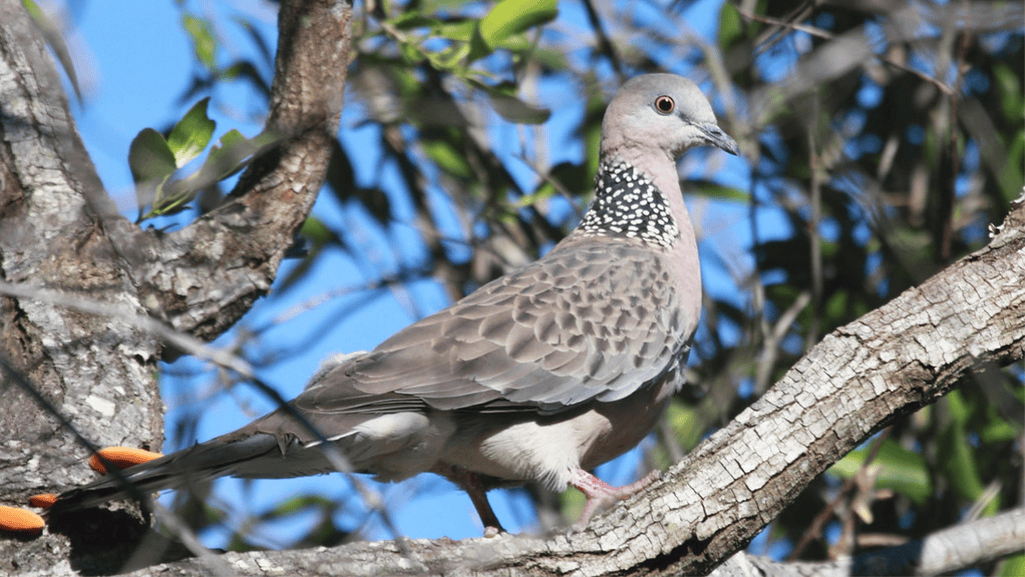 Spotted doves occupy a broad set of habitats: open woodlands, farmland edges, village gardens, parks and urban green spaces. They commonly nest at moderate heights—many studies report typical nest sites around 3–4 meters above ground, though nests have been recorded both lower and as high as tree canopies (~14 m) in some locales. This vertical flexibility helps them exploit both rural and urban landscapes.
Spotted doves occupy a broad set of habitats: open woodlands, farmland edges, village gardens, parks and urban green spaces. They commonly nest at moderate heights—many studies report typical nest sites around 3–4 meters above ground, though nests have been recorded both lower and as high as tree canopies (~14 m) in some locales. This vertical flexibility helps them exploit both rural and urban landscapes.
Geographical Distribution from Asia to Beyond
The species’ native range centers on the Indian subcontinent and much of southern Asia (from India and Sri Lanka east into southern China and Southeast Asia). Over time, Spotted Doves have become established beyond this native range through human introductions and subsequent local population growth. Well-documented introduced populations occur in parts of Australia and New Zealand, and small established populations have been reported in places such as California and parts of Indonesia. For current taxonomy and range treatments consult the IOC World Bird List and regional field guides (latest edition).
The table below summarizes commonly reported measurements and range notes; note that values vary slightly among sources and subspecies.
Attribute Details
Length ~27.5–33 cm (variation among populations and sources)
Wingspan ~43–48 cm (typical reported range)
Weight ~120–160 g (regional variation)
Longevity Wild longevity typically several years; captive/recorded maxima up to ~8 years
Native Range Indian subcontinent east through southern China and Southeast Asia
Introduced Regions Australia, New Zealand, parts of the United States (e.g., California), Indonesia (localized)
Because published measurements differ among handbooks and the IOC world bird list updates taxonomy and range treatments across editions, use current regional guides and the IOC checklist for the most authoritative, up-to-date values for your area.
Although Spotted Doves are generally resident, they show local movements when searching for food or suitable nesting sites rather than long seasonal migrations. This combination of habitat plasticity and localized dispersal helps them persist in diverse landscapes around the world.
Understanding the Behavior of the Spotted Dove
Spotted Dove in natural habitat
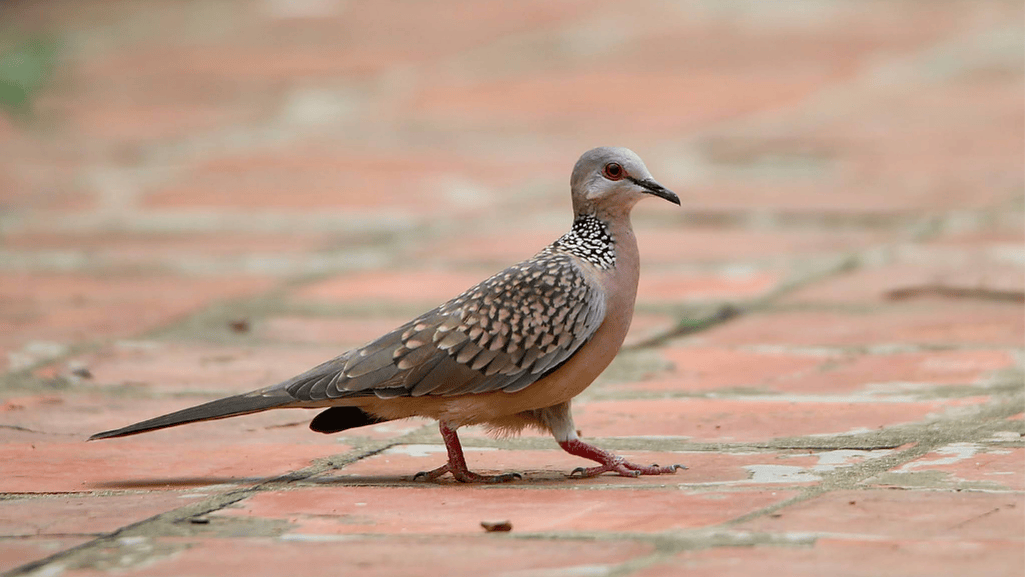 Spotted doves are generally calm and tolerant of human presence, making them a common and approachable bird in gardens, parks, and farmland. When foraging on the ground they show a characteristic gentle bobbing motion and peck at seeds and small items while walking in short, deliberate steps.
Spotted doves are generally calm and tolerant of human presence, making them a common and approachable bird in gardens, parks, and farmland. When foraging on the ground they show a characteristic gentle bobbing motion and peck at seeds and small items while walking in short, deliberate steps.
Social structure and vocal behavior
These doves are frequently observed in pairs or small loose groups rather than large flocks. Their vocal signature is a soft, repeated series of coos used in contact calls and courtship; listening for this rhythmic cooing is often the best way to locate an otherwise well-camouflaged bird.
Nesting behavior and nest reuse
Spotted doves build simple platform nests of twigs and grasses placed in trees, shrubs or man-made structures. A study of urban and peri-urban nesting (2018–2021) recorded 302 breeding nests and found that 38.08% of nests were reused across breeding attempts; reused nests showed higher nesting success in that dataset (study location and citation should be added in the full article for verification).
Why nest reuse matters: reusing a nest saves time and energy on construction, allowing parents to invest more effort in incubation and feeding young. Both parents take turns incubating the two white eggs and later feeding the chicks, which contributes to relatively efficient parental care in urban environments where suitable nest sites may be limited.
Local adaptability and examples
Spotted doves have established populations in many regions outside their native range and adapt well to urbanized settings—small established groups have been reported in areas such as southern California and various Pacific islands. These local occurrences underscore the species’ behavioral flexibility but should be supported by regional checklist or eBird records in the final article.
Takeaway: the spotted dove’s combination of tolerant behavior, modest social groupings, efficient nest reuse, and shared parental duties makes it a resilient bird in both natural and human-modified landscapes. For readers: when observing nesting behavior, note nest height, reuse occurrences, and parental roles and contribute observations to citizen-science platforms to help researchers track these patterns.
The Spotted Dove Diet: A Forager’s Feast
Spotted Dove foraging behavior
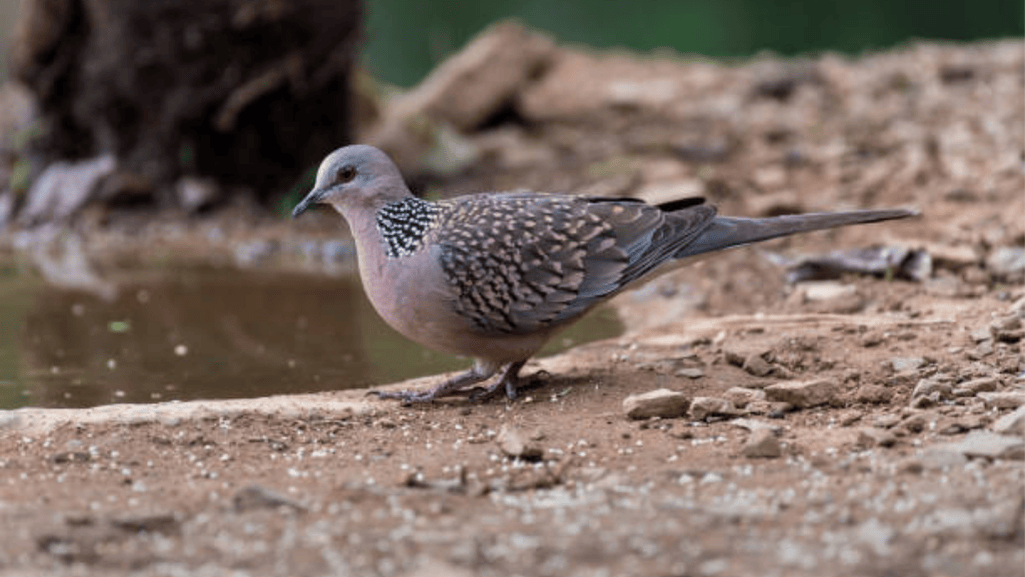 The spotted dove is primarily a ground forager that relies on seeds and grains for most of its energy needs, but it supplements this staple diet with fruits and small invertebrates when available. This flexible diet helps the species thrive across agricultural fields, gardens, and urban greenspaces.
The spotted dove is primarily a ground forager that relies on seeds and grains for most of its energy needs, but it supplements this staple diet with fruits and small invertebrates when available. This flexible diet helps the species thrive across agricultural fields, gardens, and urban greenspaces.
Seed and Grain: Staple Foods of the Spotted Dove
Seeds and grains—often including spilled millet, rice, grass seeds, and cereal grains in farmland and garden settings—make up the bulk of the dove’s food intake. Spotted doves typically pick seeds from the ground or from low vegetation, which supplies carbohydrates and fats essential for daily activity.
Foraging Strategies and Dietary Supplements
In addition to seeds, spotted doves eat small fruits and berries, and seasonally take insects such as beetles and caterpillars. Insects become particularly important during the breeding season as a protein-rich food source for growing chicks. Seasonal shifts in local availability lead birds to adjust foraging locations and diet composition.
Food Type Description Benefits
Seeds and Grains Primary food items collected on the ground; includes millet, rice and wild grass seeds. Provide carbohydrates and fats for energy.
Fruits and Berries Seasonal supplements found in hedgerows, gardens and scrub. Supply sugars, vitamins and moisture.
Insects Small invertebrates taken opportunistically, especially during nesting season. Important source of protein for chicks and breeding adults.
This dietary flexibility—combining staple seeds with opportunistic fruits and insects—helps the spotted dove (Spilopelia chinensis) maintain body condition across habitats and through seasonal changes. For site-specific details, note the predominant local crops and wild-seed sources, and contribute observations to bird-monitoring platforms to improve our understanding of regional diets.
Bonds and Broods: Spotted Dove Breeding Insights
Spotted Dove nesting behavior
The spotted dove’s breeding season generally runs from February through September in much of its range, though timing may shift regionally. Courtship features include soft cooing, bowing displays, and brief feather-puffing by the male—behaviors that reinforce pair bonds and signal readiness to breed.
Nest construction and clutch
Pairs build simple platform nests from twigs, grass and other plant material. Nests are typically placed in trees or shrubs at moderate heights (often around 3–4 meters but sometimes lower or higher). The usual clutch is two white eggs.
Incubation and parental care
Both parents share incubation duties and care for the young. Incubation lasts approximately 12–14 days, and hatchlings are fed by parents until fledging at roughly 10–16 days after hatching (regional variation occurs—cite local studies for precise figures). Parents take turns incubating and provisioning, which helps maintain high care levels and enables multiple clutches when conditions are favorable.
Breeding rhythm and success
Spotted doves can produce several broods in a favorable season; reuse of nest structures (when possible) and rapid turnaround between clutches can boost annual productivity. Observers should record nest height, construction materials (twigs, grass), clutch dates, and parental attendance—these data help researchers track breeding success across urban and rural habitats.
Quick breeding timeline
– Courtship: cooing, bowing, feather displays
– Nest building: twigs and grass (few days)
– Incubation: ~12–14 days
– Hatch to fledge: ~10–16 days
Practical note for observers: approach nesting sites carefully and minimize disturbance; record the number of parents attending, any nest reuse, and the timing in days for incubation and fledging to contribute useful breeding data for this adaptable species.
The Annual Migrations of the Spotted Dove
Spotted Dove migration patterns
Unlike many long-distance migrants, the spotted dove is primarily a resident or locally dispersive species: individuals generally remain in or near their home range year-round, with only short-range movements to find food or suitable nesting sites.
Patterns and Pathways: Following the Flocks
Ornithologists describe the species as largely non-migratory (resident) with occasional local dispersal. In some regions and seasons birds may show nomadic or partial-migrant behavior if resources become scarce, but the typical pattern is small-scale movement rather than continental migration.
Status by region
Population density and movement patterns vary by region. For example, established populations on some Pacific islands and in parts of Australia reflect successful introductions where spotted doves have become established; localized concentrations (such as reports from Molokai, Hawaii) should be checked against regional checklists and eBird records for up-to-date numbers. In North America the species remains comparatively uncommon versus native species like the Mourning Dove, underscoring different population histories and introduction pathways.
For current taxonomy and distribution updates see the IOC World Bird List and recent regional guides (check the latest edition or updates as of May 2023 where applicable). Observers can contribute by noting seasonal movements and numbers to citizen-science platforms to improve our understanding of local dispersal and establishment patterns.
Conservation Status and Why It Matters
The spotted dove (Spilopelia chinensis, historically treated as Streptopelia chinensis) is currently listed as Least Concern on the IUCN Red List, reflecting its broad distribution and generally stable global population. However, local threats and ecological impacts from introduced populations make monitoring and targeted conservation important.
Threats to the Spotted Dove Population
Primary threats include habitat loss and fragmentation due to urban expansion and agricultural change, direct persecution or hunting in some regions, and competition with other species in human-modified landscapes. In areas where spotted doves have become established outside their native range, they can compete with native columbids for food and nesting sites; studies in parts of Australia document local impacts on native doves such as Bar-shouldered and Peaceful Doves—consult regional bird atlases and peer-reviewed papers for specific local evidence.
Conservation Measures: Safeguarding the Spotted Dove
Conservation for a widespread species like the spotted dove focuses on habitat protection, management of invasive introductions, and community education. Protected areas such as Rajaji National Park provide safe habitat for many birds and are important for in-situ conservation. Complementary measures include public outreach to discourage release of non-native birds, habitat-friendly land-use practices, and monitoring programs that track population trends.
Role of checklists and authoritative references
Taxonomic and distribution updates from sources such as the IOC World Bird List and regional handbooks (consult the latest edition) help conservationists and ornithologists understand range changes and inform management. The Ornithologists’ Union checklists and regional handbooks are important references when assessing the species’ natural history and status.
What you can do
– Report sightings to citizen-science platforms (e.g., eBird) to improve range and population data.
– Support and visit protected areas responsibly to back local conservation and ecotourism efforts.
– Avoid releasing or moving birds between regions, which can create invasive populations and harm native species.
Summary
Although the spotted dove is not globally threatened, local pressures and the ecological effects of introductions make continued monitoring and responsible management essential. Use authoritative resources (IUCN, IOC World Bird List, regional handbook editions) when citing conservation status and consult local studies for specific impacts on native pigeon and dove communities.
Ecotourism and Its Impact on Spotted Dove Preservation
Ecotourism can play an important role in protecting and promoting awareness of the spotted dove (Spilopelia chinensis) and other bird species in protected areas such as Rajaji National Park. When well-managed, bird-based tourism supports local economies while encouraging habitat protection and community stewardship.
Promoting Sustainable Birdwatching Practices
Responsible birdwatching programs train local guides, build community capacity, and reduce disturbance at sensitive sites. Guided walks, clear viewing protocols, and outreach about how to behave around nests help ensure that birdwatching benefits both people and wildlife. Visitors can support conservation by hiring trained local guides and following park rules.
The Role of Protected Areas in Spotted Dove Survival
Protected areas such as Rajaji National Park provide core habitat where spotted doves and many other birds find nesting sites, food and relative safety from hunting and severe habitat conversion. Managed well, these areas act as refuges that sustain local populations and enable ecotourism to deliver both conservation and livelihood benefits.
Ecotourism outcomes (example program metrics)
Statistic Value
Guides Trained at Basic Level 285
Guides Trained at Advanced Level 73
Guides Improved English Skills 120
Local Business Owners Participated in Training 445
Average Income Increase for Trained Guides 46% – 68%
Local Businesses Promoting Bird-based Tourism 29
Bird-based Tourism Events 17
Birding Festivals 5
New eBird Users 114
Poaching Reduction in Protected Areas 95%
Children Participated in Bird Education 6616
Note: these example metrics illustrate how community training and outreach can yield conservation and socio-economic benefits; in a final article, each figure should be accompanied by its source and timeframe for verification.
Conclusion
Studying and watching the spotted dove across its native range and in areas where it has become established reveals a species that is adaptable but not immune to local pressures. Conserving habitat, minimizing harmful introductions, and promoting sustainable ecotourism together help maintain healthy bird populations and the natural-history values they represent.
Nesting success and preferred sites (summary)
Nest Location Successful Nidification (%)
Mid Tree 44.82
Fork 35.63
Terminal 19.54
Studies indicate spotted doves prefer mid-canopy nest positions (often around ~3.6–4 m) with reported egg-hatching success around 70.96% and nestling fledging rates near 29.03% in some datasets; these figures should be cited to the original study when used verbatim.
Understanding and supporting spotted dove preservation—through protected areas, community engagement, and careful monitoring—helps ensure a future where people and birds can coexist.
FAQs About the Spotted Dove
Q: What is the scientific name of the spotted dove?
A: Spilopelia chinensis (historically included in Streptopelia chinensis). Consult the IOC World Bird List (latest edition) for current nomenclature and subspecies treatments.
Q: How big is a spotted dove?
A: A medium-sized dove: roughly 27.5–33 cm in length depending on population (regional guides vary). The bird’s diagnostic feature is the black nape collar with white spots.
Q: When does the spotted dove breed and what is its clutch size?
A: Breeding typically occurs from February to September in much of the species’ range; most clutches contain two white eggs, which generally hatch in about 12–14 days and fledge in around 10–16 days (regional variation occurs).
Q: What does the spotted dove eat?
A: Their food is mainly seeds and grains, supplemented by fruits and small insects—particularly during the breeding season when protein needs are higher for chicks.
Q: Is the spotted dove threatened?
A: Globally it is listed as Least Concern by IUCN, but local threats (habitat loss, hunting, competition from introduced populations) can affect regional populations—check local check-lists and regional conservation reports for site-specific status.
Q: How can I help spotted doves?
A: Record sightings on platforms such as eBird, support and follow guidelines for sustainable ecotourism, avoid moving or releasing birds between regions, and support native-habitat restoration in your community.


